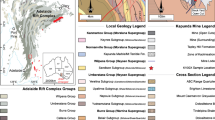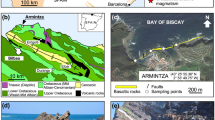Abstract
The study of coronitic textures in ferrogabbros and data on rhythmic layering of the Elet’ozero Massif supports the existence of a specific low-temperature Fe-rich liquid in nature. This liquid was formed during solidification of intrusion owing to the local multiple accumulation of Fe and Ti contents in a parental Fe-rich Fe–Ti basaltic melt. According to obtained data, this occurred on micro- and macroscale: 1) in the interglanular (intercumulus) space of the crystallization zone where intercumulus melt becomes rich in Fe and Ti owing to the crystallization of cumulus silicate minerals and is transformed into Fe-rich liquid, which concentrates residual components of an intergranular melt; 2) during formation of rhythmic layering when Fe-rich residual melt is accumulated before the upper part of the moving front of solidification; when Fe content reaches a certain limit, the melt is also transformed in a separate Fe-rich liquid, the interlayers of which form the upper (lowest temperature) members of rhythms. It was concluded that the emergence of a Fe-rich melt is related to its specific structure, which is formed when the Fe content reaches certain critical values in a liquid. Thus, this liquid is not a product of immiscible splitting of a melt, but represents a peculiar phenomenon. The preservation of primary textures and structures of the rocks is supposedly related to the lyophobic properties of surfaces, i.e., “repulsion” of nonwetting liquid by facets of cumulus crystals, especially plagioclase. Owing to this, the drops and even horizons of heavy Fe-rich liquid are retained in situ of their formation.
Similar content being viewed by others
References
R. J. Arculus and E. F. Osborn, “Phase relations in the system MgO-iron oxide-Cr2O3–SiO2” Carnegie Inst. Year Book 74, 507–512 (1975).
C. Ballhaus, R. O. S. Fonseca, C. Munker, M. Kirchenbaur, and A. Zirner, “Spheroidal textures in igneous rocks—textural consequences of H2O saturation in basaltic melts,” Geochim. Cosmochim.Acta 167, 241–252 (2015).
A. N. Bogachev, S. I. Zak, G. P. Safronova, and K. A. Inina, Geology and Petrology of the Elet’ozero Gabbroid massif of Karelia: Geology, Petrography, Petrology, and Metallogeny (AN SSSR, Moscow–Leningrad, 1963) [in Russian].
B. Chalmers, Principles of Solidification (Wiley, New York, 1964).
B. Charlier and T. L. Grove, “Experiments on liquid immiscibility along tholeiitic liquid lines of descent,” Contrib. Mineral. Petrol. 164, 27–44 (2012).
R. A. Cox and A. Indares, “Transformation of Fe-Ti gabbro to coronite, eclogite and amphibolite in the Baie du Nord segment, Manicouagan Imbricate Zone, eastern Grenville Province,” J. Metamorph. Geol. 17, 537–555 (1999).
P. Glandsdorff and I. R. Prigogine, Thermodynamic Theory of Structures: Stability and Fluctuations (Wiley-Interscience, 1971).
D. H. Green and W. H. Hibberson, “The instability of plagioclase in peridotite at high pressure,’ Lithos 5 (3), 209–222 (1970).
R. R. Hill and P. Roeder, “The crystallization of spinel from basaltic liquid as a function of oxygen fugacity,” J. Geol. 82 (6), 709–730 (1974).
E. D. Jackson, “Primary textures and mineral associations in the Ultramafic Zone of the Stillwater complex, Montana,” US Geol. Surv. Prof. Paper 358, (1961).
J. K. Jakobsen, I. V. Veksler, C. Tegner, and C.K. Brooks, “Crystallization of the Skaergaard Intrusion from an emulsion of immiscible iron-and silica-rich liquids: evidence from melt inclusions in plagioclase,” J. Petrol. 52 (2), 345–373 (2011).
C. Jaupart and G. Brandeis, “The stagnant bottom layer of convecting magma chamber,” Earth Planet. Sci. Lett. 80 (1/2), 535–538 (1986).
S. P. Korikovsky, “Prograde transformations of gabbronorites during eclogitization in the temperature range 600–700°C,” Russ. Geol. Geophys. 46 (12), 1333–1348 (2005)
A. A. Kukharenko, M. P. Orlova, and E. A. Bagdasarov, Alkaline Gabbroids of Karelia (LGU, Leningrad, 1969) [in Russian].
T. L. Larikova, “Genesis of drusitic (corona) textures around olivine and orthopyroxene during metamorphism of gabbroids in Northern Belomorie, Karelia,” Petrology 8 (4), 384–401 (2000).
Layered Intrusions, Ed. by R. G. Cawthorn, Developments in Petrology (Elsevier, 1996), Vol. 15.
A. A. Polkanov, N. A. Eliseev, E. N. Eliseev, and G. N. Kavardin, Gremyakha Vyrmes Massif, Kola Peninsula (Nauka, Leningrad, 1967) [in Russian].
I. D. Ryabchikov and L. N. Kogarko, “Oxygen potential of the Elet’ozero magmatic system as a criterion of the ore potential for titanomagnetite–ilmenite raw material,” Dokl. Earth Sci. 463 (1), 680–683 (2015).
E. V. Sharkov and A. V. Chistyakov, “Coronitic structures in the ferrogabroids of the Elet’ozero intrusive complex (North Karelia, Russia) as evidence for the existence of Fe-rich melt. 1. Types of Coronas,” Geochem. Int. (in press).
E. V. Sharkov, Formation of Layered Intrusions and Related Mineralization (Nauchn. Mir, Moscow, 2006) [in Russian].
Sharkov, E. V. I. S. Krassivskaya, and A. V. Chistyakov, “Dispersed mafic–ultramafic intrusive magmatism in Early Paleoproterozoic mobile zones of the Baltic Shield: an example of the Belomorian Drusite (Coronite) Complex,” Petrology 12 (6), 561–582 (2004).
E. V. Sharkov, B. V. Belyatsky, M. M. Bogina, A. V. Chistyakov, V. V. Shchiptsov, A. V. Antonov, and E. N. Lepekhina, “Genesis and age of zircon from alkali and mafic rocks of the Elet’ozero Complex, North Karelia,” Petrology 23 (3), 259–280 (2015).
Shchiptsov, V. V. Industrial minerals of the Tikshozero–Eletozero alkaline ultramafic-carbonatitic and alkaline gabbroic complexes in Karelia, Russia In 12 SGA Biennial Meeting Mineral Deposits Research For a High Tech World. Uppsala, Sweden, 2013. Proceedings rhythmic (Uppsala, 2013), Vol. 4, pp. 1781–1783.
E. D. Shchukin, A. V. Pertsov, and E. A. Amelina, Colloid Chemistry (Akademiya, Moscow, 2007).
I. V. Veksler, A. M. Dorfman, A. A. Borisov, R. Wirth, and D. B. Dingwell, “Liquid immiscibility and the evolution of basaltic magma,” J. Petrol. 48, 2187–2210 (2007).
L. P. Wager and G. Brown, Layered Igneous Rocks (Freeman, San Francisco, 1967).
C. Y. Wang and M. I. Zhou, “New textural and mineralogical constraints on the origin of Hongge Fe–Ti–V oxide deposits, SW China,” Miner. Deposita 48 (6), 787–798 (2013).
Whitney P. R. and J. M. McLelland, “Origin of biotite–hornblende–garnet coronas between oxides and plagioclase in olivine metagabbros from Adirondack Mountains, New York,” Contrib. Mineral. Petrol. 82, 14–41 (1983).
Zhou, M.-F. W. T. Chen, C. Y. Wang, S. A. Prevec, P. P. Liu, and G. Howarth, “Two stages of immiscible liquid separation in the formation of Panzhihua-type of Fe–Ti–V oxide deposits, SW China,” Geosci. Front. 4 (5), 481–502 (2013).
Author information
Authors and Affiliations
Corresponding author
Additional information
Original Russian Text © E.V. Sharkov, A.V. Chistyakov, 2017, published in Geokhimiya, 2017, No. 7, pp. 609–617.
Rights and permissions
About this article
Cite this article
Sharkov, E.V., Chistyakov, A.V. Coronitic textures in the ferrogabbros of the Elet’ozero intrusive complex (Northern Karelia, Russia) as evidence for the existence of Fe-rich melt. 2. Origin of Fe-rich liquid. Geochem. Int. 55, 621–628 (2017). https://doi.org/10.1134/S0016702917070096
Received:
Accepted:
Published:
Issue Date:
DOI: https://doi.org/10.1134/S0016702917070096




